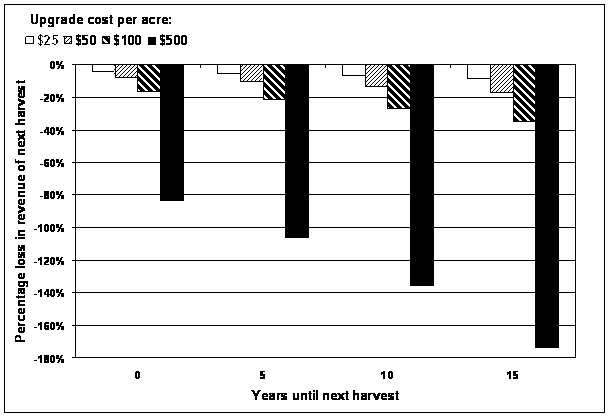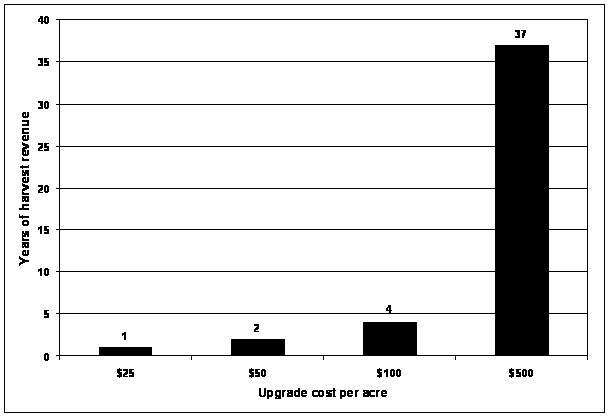 |
 |
 |
 |


Fact Sheet # 12:
Economic impacts of RMAPs and required road upgrades on small forest
landowners in Eastern Washington
|
2002 By Kevin Zobrist Save or Print a PDF copy of Fact Sheet #12
To demonstrate the potential economic impacts of RMAP compliance on both smaller and larger Eastside NIPF landowners, consider two hypothetical examples. Landowner 1 has 100 acres, which is harvested every 20 years. Landowner 2 has 1,000 acres, which is large enough to support a sustainable annual harvest of 50 acres. Both cases assume a selective-harvest yield of 3 Mbf/acre at a stumpage value of $200/Mbf for a total revenue of $600 per harvested acre.
Example 1: Landowner with 100 acres A small landowner with 100 acres who only harvests every 20 years may have to borrow money to finance road upgrade costs and pay it back with interest out of revenues from the next harvest. Figure 1 below shows the impact on harvest revenues from borrowing money at a real interest rate of 5% to cover road upgrade costs of $25, $50, $100, and $500 per acre, representing a total cost of $2,500, $5,000, $10,000, and $50,000 respectively.
Figure 1: Impact of road upgrade costs on revenues from the next harvest. This shows the percentage of revenues from the landowner's next harvest that would be lost to pay off money borrowed for road upgrades. The impacts vary depending on how many years are left until the next harvest, with larger impacts resulting from road costs incurred earlier in the cutting cycle. Losses greater than 100% reflect a scenario in which the compounded cost of RMAP compliance exceeds revenues from the next harvest and will require additional cash-out-of-pocket expense. Example 2: Landowner with 1,000 acres A landowner with 1,000 acres has the advantage of an annual cash flow of $30,000 (based on revenues of $600/acre with 50 acres harvested/year) to apply towards road upgrades. However, in some cases this cash flow may be inadequate to cover the costs of road upgrades, so the landowner may also have to borrow funds against future harvests. In this case, the landowner may forfeit several years' harvest revenue to pay for the road upgrades plus interest. Figure 2 below shows the number of years of sustainable harvest it would take to pay for road upgrade costs of $25, $50, $100, and $500 per acre, representing a total cost of $25,000, $50,000, $100,000, and $500,000 respectively. A 5% real interest rate is assumed.
Figure 2: Years of harvest revenue required to pay for road upgrades. This shows the number of years the landowner would have to forfeit harvest revenues before road upgrade costs are paid off.
Discussion: The economic impacts of RMAP compliance costs depend on both the cost of the upgrade and the size of the ownership. For landowners with smaller ownerships who rely on periodic income from their forest, the timing of road upgrades is critical. If road upgrades occur at the same time as a timber harvest, the harvest revenues can help cover the costs. If upgrade costs are $50/acre or less ($5,000 for the 100-acre example), the landowner will not spend more than 8% of the harvest revenue on road upgrades. If those costs were doubled ($10,000), the landowner would spend 17% of the harvest revenues on road upgrades. Put another way, harvest revenues from 17 acres of the 100-acre example would be dedicated towards RMAP compliance. Impacts would be higher if the road upgrades were done several years before the next harvest and the landowner had to borrow money to finance the cost. For instance, if $5,000 ($50/acre) were borrowed 10 years before the next harvest, it would take 14% of that harvest to pay back the loan at a 5% real rate of interest. If the borrowing interest rate were higher, such as 8%, it would take 18% of the next harvest to pay back a $50/acre road expenditure with funds borrowed for 10 years. In extreme cases, small ownerships with large RMAP compliance costs may never be able to cover the costs out of future harvest revenues. Because the cost of borrowing money is high, small landowners with inadequate cash flow to cover RMAP costs may elect to do the next harvest sooner than originally scheduled. A premature harvest might have to be done more intensively to produce adequate yields, and it would deviate from sustainable management and compromise the landowner's ability to do future harvests. Landowners with large enough ownerships to sustain an annual harvest have the advantage of a steady stream of harvest income that provides greater cash-flow flexibility to help pay for road upgrades. If road upgrades are relatively inexpensive, the landowner may not have to borrow money to finance them. The landowner may still lose a large portion of a given year's income, however. For more expensive road upgrades that exceed a given year's harvest income, a landowner may have to borrow money and pay for road upgrades over several years. For an upgrade cost of $50/acre ($50,000 for the 1,000-acre example), almost two years of harvest income would be required to cover the cost. That amounts to 85 acres of harvest revenues expended towards RMAP compliance. Some landowners may elect to cover costs by harvesting more intensively or across a broader area in the year that road upgrades are done. However, this would compromise the landowner's ability to continue a previously sustainable rate of harvest. It is important to consider that the above examples do not include taxes and administrative costs that further reduce the amount of harvest revenue available to pay for RMAP compliance. They also do not include harvest revenue reductions associated with other aspects of current forest practice rules, such as riparian zone harvest restrictions. For a detailed discussion of the impacts of riparian harvest restrictions on Eastern Washington landowners, please refer to RTI Fact Sheet #3. The combined impacts of riparian buffers and RMAP compliance could
be substantial for some landowners. These impacts may reduce the
attractiveness of forestry as both an enterprise and an investment,
which is significant given current concerns about the rate of non-industrial
private forestland conversion to commercial and residential land
uses in Washington. The Department of Natural Resources estimates
that forestlands in Washington are being converted at a rate of
100 acres/day (Our Changing Nature, 1999).
Information in this fact sheet is provided by the Rural Technology Initiative. For more information, please visit the RTI website at www.ruraltech.org or contact: Kevin Zobrist The following fact sheets may also be of interest:
|




